TODAY AT PMA
Sneaking a Peek
 By MIKE PASINI
By MIKE PASINIEditor
The Imaging Resource Digital Photography Newsletter
LAS VEGAS, Nev. -- For three hours this afternoon, over 400 members of the press wandered from table to table viewing over 100 companies' offerings at PMA Sneak Peek.
|
|
Imaging Resource did more than wander with two video crews and two still photographers. The Etchells-Deuel and Barnett-Smith video team, shooting with Canon XL and GL2 camcorders, were matched by News Editor Michael Tomkins shooting with a new Nikon D40 and your newsletter editor shooting with a Nikon Coolpix 990 from the last century. The 990 was fondly remembered by a number of people in attendance -- more fondly, perhaps, than your newsletter editor.
SLIDE SHOW & GALLERY | Back to Contents
You can view our Flash slide show of 37 images from the event or, if you prefer, our HTML gallery of the same images. Both productions were created with Adobe Lightroom 1.0, which included image selection and editing, too.

Aaland
WANDERING IN THE DESERT | Back to Contents
Our tour of the tables got off to a rocky start when O'Reilly (http://www.oreilly.com) author Mikkel Aaland ran into us. Literally. When we got up off the rug, we observed he again was dragging his luggage with him. "When are you going to start staying in hotels?" we asked. But it was an unfair question. He couldn't respond with his mouth full.
The carving table, the appetizers, the full bar were grand distractions, but Mikkel introduced us to a digital imaging envangelist from the very beginnings of this revolution whose name we feel protect given his heretical opinions. His great concern these days, he confided, is preserving all these images we're taking. They're essentially emphemeral. Long ago, he advised Kodak to include a film recorder in their kiosks so consumers making prints at a convenience store could walk out with an archival filmstrip of their images.
"Film?" we asked. "But that's dye-based. How can that survive?"
"Modern color film is can last up to 700 years," he explained. "And it's human readable."
These evangelists can really confuse you, we thought to ourselves as we started our tour of the tables.
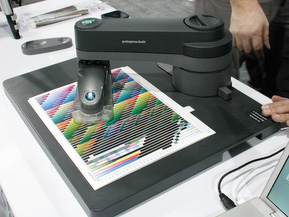
i1-iO
X-RITE | Back to Contents
At the X-Rite table (http://www.xrite.com) we saw the new and under $2,000 i1-iO scanning table. With an X-Rite i1PRO spectrophotometer attached, it automatically reads test charts as thick as 10mm (from "thin polybag material to ceramics and textiles," we were told). And it does it faster -- and more accurately -- than a human can, too.
We asked how difficult it was to align a test sheet so the automatic arm could accurately find the samples. No problem. You manually show the arm the corners and it takes it from there. Impressive.
NORCENT DIGICAMS | Back to Contents
Call it exceptional consumer value, if you like, but the game packing features into a compact, stylish yet inexpensive box is one of the new sports in this business. Take Norcent (http://www.norcent.net), for example.
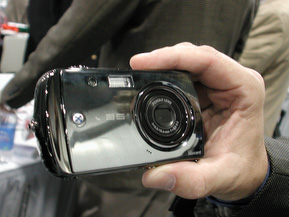
Xias
The Xias DCS-760 is a 7-megapixel digcam with a smoked charcoal metallic finish, 3x optical zoom with 4x digital zoom, taking SD cards and a scratch-resistant 2.5-inch LCD. You'll be able to find it for $199 in April.
The company has two other compact lines including the $129-179 25 Series and the 10-Mp 50 Series with a 3-inch LCd, face detection and anti-shake software for a good bit more.
DIVX | Back to Contents
Pentax and Casio, at least, are competing with new features like DivX certification (http://www.divx.com). Jennifer Culter took a short video of our hand talking on a 10-Mp Pentax Optio A30, popped the SD card into a DivX-certified DVD player and with no copying, conversion or magic, played the video.
DivX is ambitious. It wants to be a "common media language" so DivX files can play on any certified device, sort of the PostScript of video. The company has a content-oriented Web site called stage6 (http://www.stage6.com) that allows content creators to share their videos without the quality degradation of sites like YouTube.
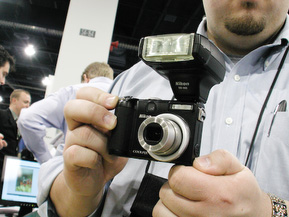
Coolpix 5000
NIKON | Back to Contents
At the Nikon table (http://www.nikon.com) we were warmly received with the venerable Coolpix 990. We had to hand it off to try out the new D40x, the just-announced 10.2-Mp sibling of the popular D40.
But the big news was the new 55-200mm VR f4-5.6 stabilized lens that will only set Nikonians back $250. It's VR I not VR II but it's $250, not $700. The D40x won't sell in a kit version with it for a while, but you can get the body only for $729 and tack on the new 55-200mm lens for $979. You can also get it kitted with an 18-55mm zoom for $799 or the 18-135mm for $1,029.
We also got a peek at the Nikon Coolpix 5000, the one with a hot shoe. This one had a Nikon SB-400 flash attached. Very cool. Too bad the LCD doesn't swivel. We might have left the 990 at the table.
BAGS | Back to Contents
What's a camera without a camera bag? Naked. Several bag companies were showing their wares, but one in particular got our attention. We'd recently gone through the stores trying to find a good holster bag for a dSLR and eventually did pick up a Lowe we like. But we were making a few compromises.
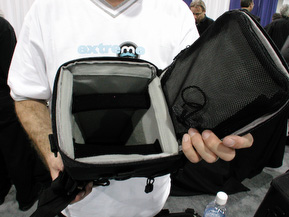
Teton
The Teton holster we saw at the M-Rock (http://www.m-rock.com) table, however, did not compromise. The first thing that attracted us to it was the large mouth, which accommodates a vertical grip. It also came with a weather jacket and bungie straps on the bottom to grab a jacket or a light tripod. And two straps so you can wear it over your shoulder or attached to a backpack or on your chest. It even includes a lens cloth. Total damages are just $60.
We also liked their $100 Everglade dSLR bag with configurable compartments and a U-shaped lens cradle. Plus all the extras of the Teton. The lightweight bags are all made with plastic and foam panels.
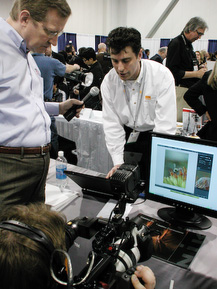
Dfine With U Point
U POINT | Back to Contents
Nik Software (http://www.niksoftware.com) was showing the first application of its U Point technology outside Nikon's Capture NX. It has revamped Dfine, its noise reduction software, using the revolutionary masking interface.
Look for the video of this spectacular application. It made us hope we'll be seeing U Point show up in more places soon.
ZIGVIEW | Back to Contents
Now that Canon has joined Olympus with a live LCD dSLR, you might feel a bit antiquated peering through your camera's eyepiece. But you can swap it out for a Zigview S2 (http://www.secu-line.com/) and have not only a live view but one an articulated LCD that won't interfere with autofocus.
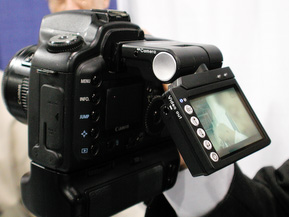
Zigview
Secu-line's Soon-Gi Jang demonstrated the Zigview on a Canon. The lith-ion battery has a run time of about two hours, he said. The LCD can be detached from the mount and actually fire the camera via a cable connection. You can also plug in a video cable to focus on a TV screen.
WIRELESS USB | Back to Contents
It's coming. In the next generation of cameras that support USB. In the next generation of laptops. In the next generation of any device with USB support, that USB will be Wireless USB.
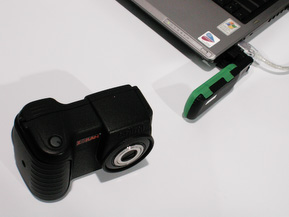
Wireless USB
Artimi (http://www.artimi.com) develops wireless semiconductors for USB electronics. At their table, they had a digicam retrofitted with Wireless USB and a USB dongle plugged into a laptop. They took some shots and wirelessly transmitted them to the laptop and then printed them on a printer with Wireless USB. No wires.
They had to be within a few inches, but the spec supports transfer to three meters. And it's as fast as USB 2.0 Hi-Speed at 480 megabits a second.
IMAGE TRENDS | Back to Contents
The guys from Image Trends (http://www.imagetrendsinc.com) announced two new applications priced at $49.95 each and showed both at their table.
DustKleen is an automatic dust removal program with manual touch up controls for scanned images from both film and prints. SensorKleen a semi-automatic SmartBrush that removes artifacts created by dust and debris on the dSLR sensor cover. These products are, at the moment, Windows-based stand alone applications but Mac versions will follow, Mike Conley told us.
What appealed to us about them was that no matter how much you went over an area, you couldn't overdo it. It was like error-free spotting.
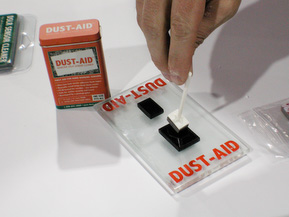
Dust-Aid
SENSOR CLEANING | Back to Contents
We saw a couple products that claim to safely clean dSLR sensor covers. And they couldn't have been more different.
Dust-Aid (http://www.dust-aid.com) is the simple one. The dirty work is done by a foam pad with an adhesive on the working end that leaves no residue, like a Post-it note. In fact, it isn't very tacky. We touched it and it hardly grabbed. But it's enough to lift dust off your sensor cover.
You attach it to a small plastic wand with a comfortably large flag-like grip. It's offset from the wand's pole so you can see what the pad is doing. For $39.95 you get a set of pads and the wand in a small tin. Enter the code "PMA07' in the order form on the Web site for a $5 discount during the show. You'll also be able to buy just replacement pads soon, we were told.
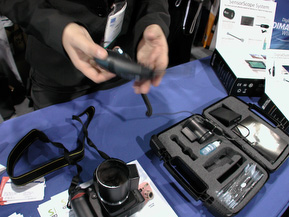
SensorScope System
On the other end of the spectrum is Delkin's $189 SensorScope System (http://www.delkin.com). The system includes a SensorScope that mounts on your dSLR's lens opening and illuminates with magnification the sensor cover, a SensorVac that runs from a battery pack or USB, SensorWands, SensorSolution for the wands, a carrying case DeWalt would be envious of and a user manual.
JOBO | Back to Contents
Jobo (http://www.jobo.com) had its Spectator storage and display device, the new Giga Vu Pro storage and display device and the photoGPS device, which attaches to your dSLR's hot shoe to record GPS data as metadata for each shot with no extra cables (which can run $100 with conventional GPS systems).
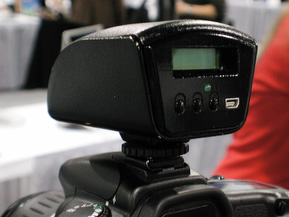
photoGPS
The photoGPS intrigued us. No cable? The device is triggered by the flash signal in the hot shoe and stores the data for each shot in its internal memory. With the included software, the GPS data is downloaded via USB and merged with the image data.
Our video crew did a piece on this worth watching for.
LENSBABIES | Back to Contents
They were also over at the Lensbaby table where the company was showing off its new medium format Lensbaby (http://www.lensbabies.com).
There's a Medium Format Lensbaby 3-GB for the Mamiya 645 and Pentax 67 camera bodies. The Lensbaby 3-GB for Mamiya 645 features an 80mm fixed focal length and possible aperture settings ranging from f3.4 to f39. The Lensbaby 3-GB for Pentax 67 cameras has a 100mm fixed focal length and has possible aperture settings ranging from f4 to f45.
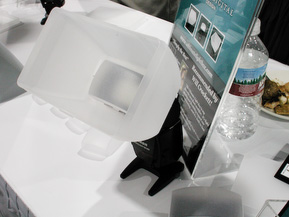
Ultimate Light Box
FLASH DIFFUSION SYSTEM | Back to Contents
Meanwhile, we were intrigued by a flash diffusion system from Ultimate Light Box (http://www.ultimatelightbox.com). It starts with a custom plastic mount available for about twenty different external flash units. To that you can add a simple $19.95 domed diffuser (mount included), a $24.95 light box (which functions like a soft box), a $6.95 mini reflector (the light box without a diffuser in front), a $19.95 black box (a black rather than diffused light box), sensor shields (to block light on one or another side of a light box) and colored gels.
We particularly liked the diffuser material itself. It diffused light but it wasn't milky. It looked more like pebbled glass, transmitting more light than we might expect.
HAVE A LITTLE FUN | Back to Contents
The aVinci Experience (http://www.sequoiamg.com/) transforms your photos and videos into a multi-media production (from DVDs to books) "using the latest Hollywood effecs and themed storyboards." It's coming to a kiosk near you soon, too.
But we found the templates polished designs and the production work simple in our brief demo. Impressively, the system can produce a DVD with a printed cover in a case with a printed cover insert.
BUT GET SERIOUS | Back to Contents
We did enjoy a peek at two fine art paper lines, one from Innova (http://www.innovaart.com) which replicates the fiber sheets of the past and another from Hahnemuhle (http://www.hahnemuhle.com). Both firms provide ICC profiles for their papers for a variety of printers. Innova's are actually done by a professor at the Rochester Institute of Technology while Hahnemuhle's are done inhouse.
TRIPOD HEADS | Back to Contents
We caught one of our video crews admiring the tripod heads form Acratech (http://www.acratechusa.com), particularly the Ultimate Ballhead, which weighs less than a pound and the Long Lens Head, which can support a 600mm f4.0 lens with perfect balance.
PEEK A BOO | Back to Contents
For a Sneak Peek, PMA's three hour table hopping treat was a show in itself. Be sure to see the companion Flash slide show or HTML gallery.

